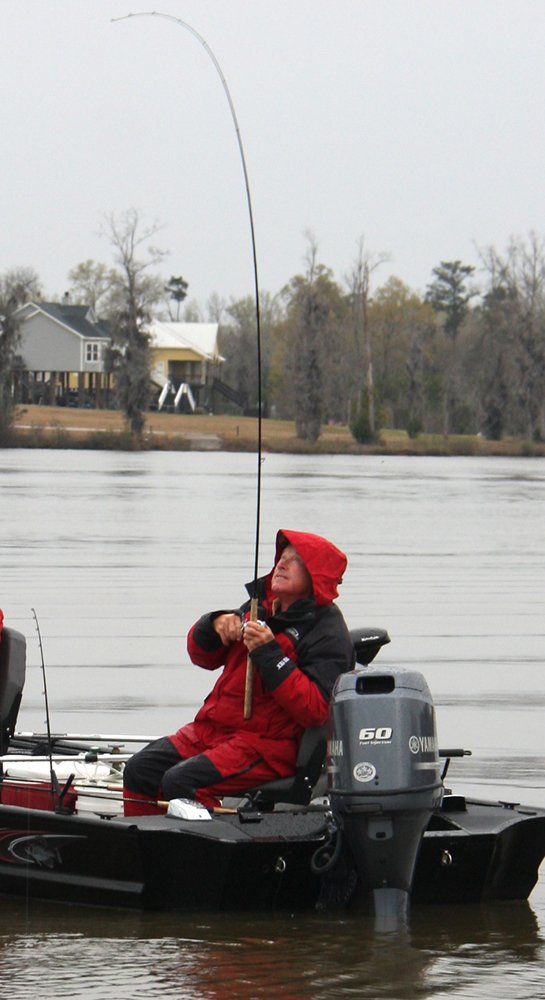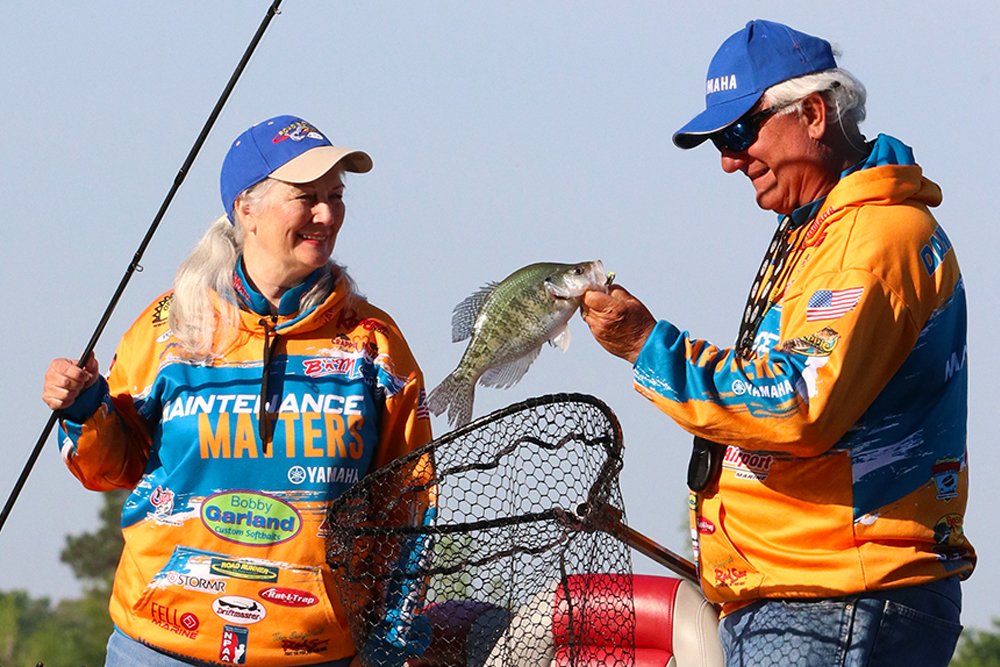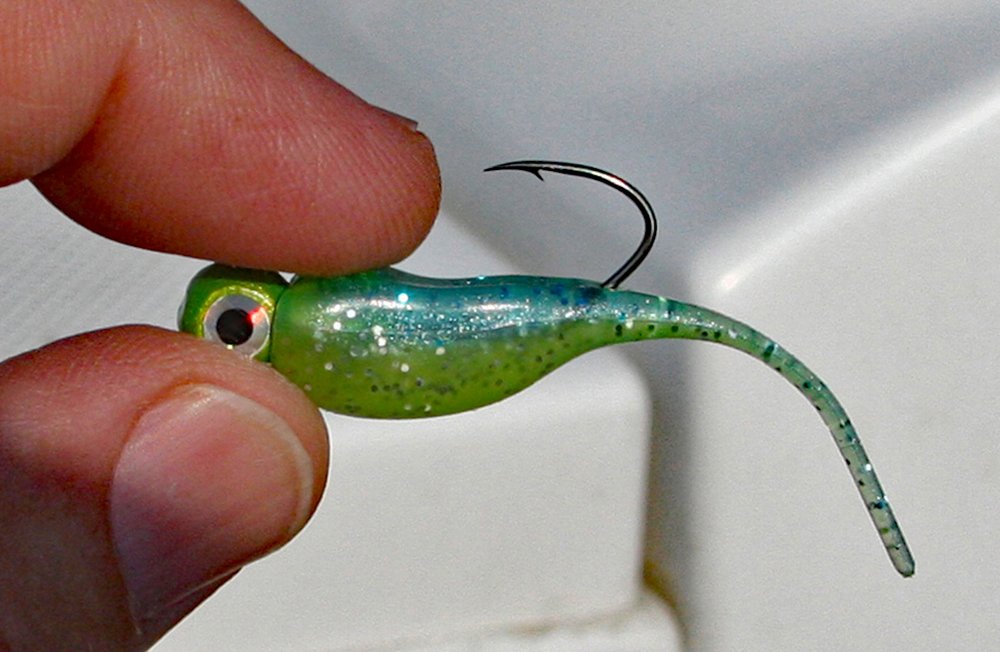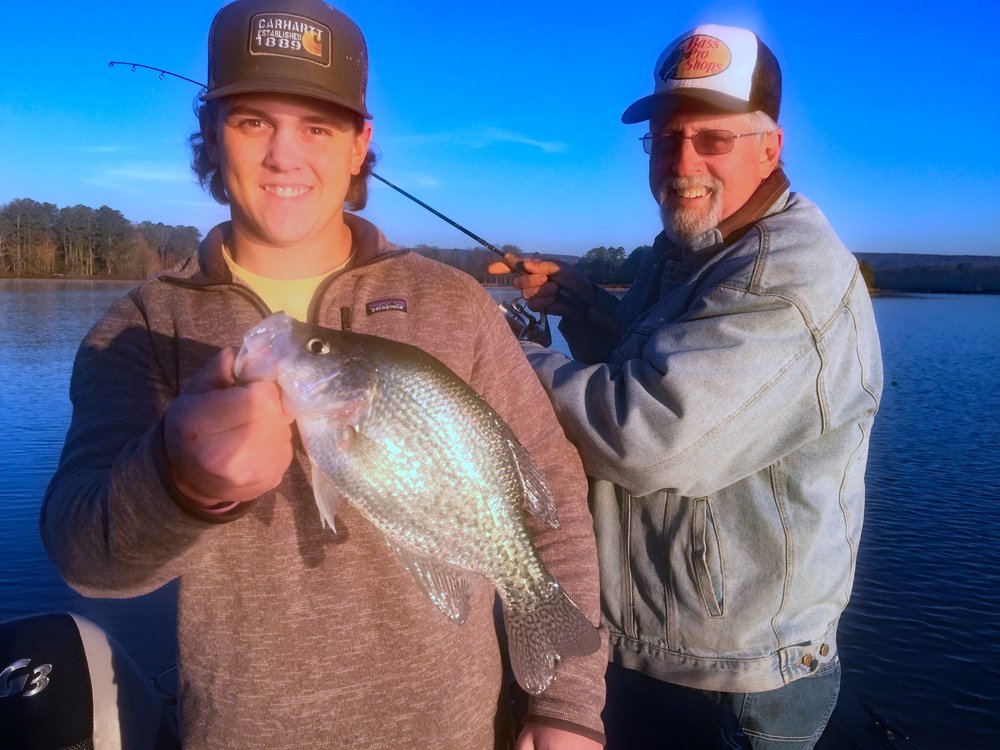Sure, winter fishing can be cold, as far as the weather is concerned. But it can still provide hot crappie fishing. (Photo: Richard Simms)
Crappie Action in Dead of Winter
by Tim Huffman
Crappie action isn’t dead just because the temperatures are frigid. Fishing can be good if a fisherman is prepared and able to handle the cold weather.
Crappie don’t hibernate or become totally dormant in cold water. They are cold-blooded so they do become slow, conserve energy and often seek deep water. However, good electronics and experience has taught us that crappie still eat and can be found can be caught in numbers. We’ve also learned the depth of crappie in cold water isn’t always the deep-water haunts as once believed. Depending upon the lake and temperatures, they’ll likely be found in the mid-depths and even in very shallow water, so keep an open mind when searching.

Hard bites, Speed up
Roger Gant perfected and made popular the art of side-pulling. He won a Crappie Masters National Championship and spent many years as a Pickwick Lake fishing guide. “The biggest fish I catch are in the winter. The bites are more deliberate, too. When a fish is sitting there in the winter, there isn’t as much food available so when something comes by, he goes for it and gets it. A fish won’t mess around with a bait like they do other seasons.
“Everyone knows presentations must be slower in the winter. However, I prefer to go as fast as the fish will let me go. When I’m catching fish, I’ll keep speeding up until they quit biting, then slow back down a little. That’s something that has worked for me.”
Warm Discharge Waters
There are many waters scattered around the country that have warm water discharges, like the power plant lakes. On some of the coldest days of the year, the warm water draws shad and the shad draw predators.
Don’t fool around. Head straight for warm water and check the obvious structures including points and drop-offs. Crappie are often in the mid-depths and shallower water. A float-and-jig is good for working areas just before they break off into deeper water.
Fish Slow

Dan Dannenmueller, tournament fisherman and CrappieNOW publisher, says, “Slow trolling is a good method in the winter. The fish are lethargic. LiveScope has shown that many times the fish will rest on bottom with their bellies touching bottom. We sometimes see mud on them when we catch them. The key is to go 0.1 or 0.2 mph, or better yet, just stop when you see fish. Leaving the baits in front of the fish will often trigger bites.
“Shad is a key any time of year. Find an area showing shad on the electronics and you’ll likely be in a good spot. Pay attention to drop-offs and cover on the drops. Those spots hold crappie and with shad moving in and out, the fish will likely be active.
“My last tip for winter would be to go to single rigs when fish are slow to hit and you’re having to put baits into cover. It’s important to be quiet, not hang baits up in the cover you’re fishing and make slow presentations. A single bait makes it easier.”
“…go to single rigs when fish are slow to hit and you’re having to put baits into cover.”
Under the Ice
Ice fishing is going full speed. Devils Lake in North Dakota is a go-to northern destination. Tanner Cherney, fisherman and tourism for the lake, says the natural-formed glacier lake is a huge, clear body of water.
“Walleye and perch are popular targets under the ice here, but crappie fishing has taken a big jump. Fishing is nothing fancy. Jigging a little rattle spoon of some type, in 1/16-ounce, and look for fish in 30 to 35 feet of water. I also like to use a slip-bobber with a jig for a second presentation. The key is to use two-pound-test line and ultralight on everything.
“Presentations vary with the mood of the crappie, but changing it up is important when fish are slow to hit. A combination of jigging and stopping is usually a good action.”
Bait

Bait size is always important and seems to vary with each fisherman and lake. Never discount downsizing when the bite is slow and tough, but don’t ignore trying medium and larger offerings to allow fish to show you which ones they prefer.
Safety
Temperatures can be brutal in the middle and northern states, but dead-of-winter fishing can be hot. Nothing is more critical than making a plan to stay safe and comfortable. A fisherman can’t enjoy a trip if he’s shivering and freezing cold. Be prepared with proper clothing, boots and headgear. A safe heater is a good addition in the boat. Above all, it’s good to take a partner because a fall into the lake means getting back into the boat and battling hypothermia. A partner can save a life. A spare bag with a towel, socks, toboggan and old pair of coveralls is a good idea, too.
(Tim Huffman has specialized in crappie fishing, writing and photography since 1988. He is currently the Editor/Senior Writer for Crappie Masters Magazine, freelance contributor to four magazines, book author and Senior Writer for CrappieNow Digital Magazine.)


